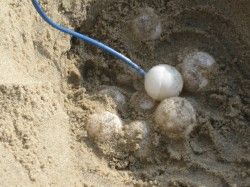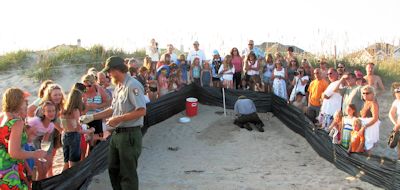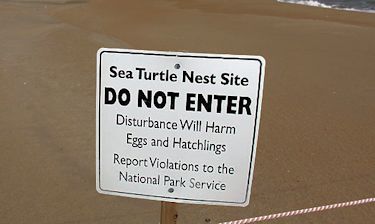Reprinted From the Outer Banks Voice
HATTERAS– Eric Kaplan sees the day when new technology will help predict the beginning of life for one of nature’s oldest species.
Kaplan, founder of the non-profit Hatteras Island Ocean Center, is a former technology company owner who was on the cutting edge of developing Bluetooth and other modern products.
Supporter Spotlight
Now, he is part of a project that could narrow the time needed for beach closures to protect sea turtle nests.
 A probe is placed in a turtle nest. Photo: Outer Banks Voice |
Funded primarily by IBM, the project is called “Turtle Sense,” and according to Britta Muiznieks, a wildlife biologist for the National Park Service, it is still “in its infancy.”
But Cape Hatteras National Seashore managers hope the new technology will someday signal when sea turtles eggs will hatch from nests buried in the sand.
“Previous studies have been unsuccessful in predicting these events with reliable accuracy,” Muiznieks said.
When a sea turtle nest is found on a National Park Service beach, a small enclosure is built around the site to keep pedestrians and vehicles away. After a turtle digs a nest, it takes anywhere from 55 to 80 days for the turtles to hatch. Each nest contains 75 to 150 eggs.
Supporter Spotlight
The Park Service expands the nest closures to the surf line 50 to 55 days after the eggs are laid. The tiny turtles, once they hatch, parade to the surf from their nest near the dune line.
During this period, the beach is effectively closed to vehicular traffic.
A number of factors affect when a nest will hatch. But one of the largest is thought to be the ambient temperatures in the nest itself.
According to Muiznieks, cool ambient temperatures prolong incubation periods while hot temperatures shorten the development time.
 A crowd gathers at Cape Hatteras National Seashore to watch rangers excavate a turtle nest. Photo: NPS |
Humidity and oxygen levels can also affect the incubation period.
Given the number of days in the hatching window, portions of beach can be closed for more than a month.
National Park Service and IBM together are planning on placing sensors in four nests to begin gathering data. The sensors will record nest temperatures and, hopefully, detect motion within the nest. The information will be transmitted cell phones.
This data will be overlain with human observation to record when the nests actually hatch, or “boil,” as biologists term the event.
It is hoped that the sensors will be able to help predict, within a much narrower window, when a turtle nest is about to boil, and if successful, it could significantly reduce the amount of time Cape Hatteras will need to block off large portions of the beach.
Kaplan and Muiznieks are working with IBM’s Tom Zimmerman to improve the technology.
From previous studies, scientists know that measuring ambient nest temperature is not accurate in predicting when a nest is about to hatch.
That is why sound is being added to temperature data in this season’s study.
 Officials at Cape Hatteras National Seashore hope the new technology may one day reduce the length of beach closures because of turtle nests. Photo: NPS |
Kaplan and Muiznieks want people to understand the process will take some time and the outcome is uncertain.
“We are hoping that by simultaneously measuring movement and temperature fluctuations and entering this into a computer model that will analyze the data from each nest every two hours, we will be able to accurately predict hatching events” Muiznieks said.
“We need to make sure that the shifting of eggs that occurs naturally within a nest can be distinguished from the shifting of eggs as the hatchlings emerge from their eggshells. “
To be even more accurate, the method could include gas measurements to determine the embryos’ stage of development.
“At this point we are still trying to figure out exactly what we need to be measuring to give us the most accurate results,” Muiznieks said.
Kaplan suspects it will take at least three to five years of data collection before they know if the technology is “ready for prime time.”
Still, the effort shows the Park Service is working hand-in-hand with a private sector entrepreneur and one of the largest technology companies in the world in an attempt to shorten beach closure times.
And if the program is successful, the technology could be used all over the nation and the world.







